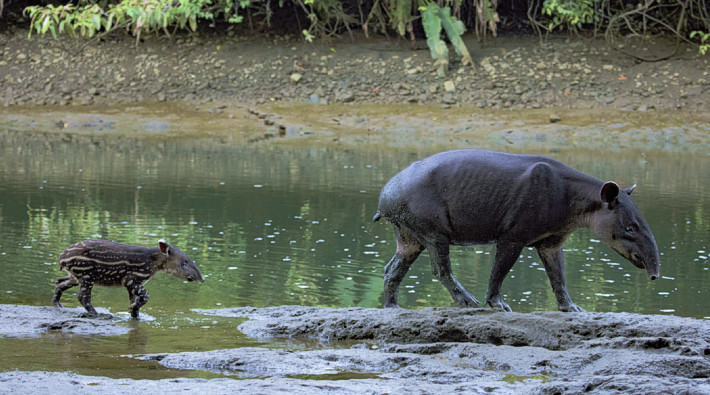Notable comportamiento maternal del tapir centroamericano (Tapirus bairdii) en el Parque Nacional Corcovado, Costa Rica
DOI:
https://doi.org/10.31687/SaremNMS23.8.3Palabras clave:
cría, mamífero, nado, Perissodactyla, río SirenaResumen
La danta centroamericana (Tapirus bairdii) prefiere hábitats con cuerpos de agua en las inmediaciones. El 3 de diciembre de 2021 registramos una hembra de tapir y su cría cruzando el río Sirena, Parque Nacional Corcovado, suroeste de Costa Rica. La cría siguió a su madre cuando entró al río; sin embargo, en la parte más profunda del río la madre se sumergió por unos segundos y cuando salió la cría estaba encima de ella, continuando así hasta cruzar el río. Este comportamiento podría ser una adaptación local para proteger a las crías de depredadores como cocodrilos y tiburones toro.
Citas
Daly, R., P. W. Froneman, & M. J. Smale. 2013. Comparative feeding ecology of bull sharks (Carcharhinus leucas) in the coastal waters of the southwest Indian Ocean inferred from stable isotope analysis. PLoS One 8:e78229. https://doi.org/10.1371/journal.pone.0078229.
Endo, H., M. Yoshida, T. S. Nguyen, Y. Akiba, M. Takeda, & K. Kudo. 2019. Three-dimensional CT examination of the forefoot and hindfoot of the hippopotamus and tapir during a semiaquatic walking. Anatomy, Histology, Embryology 48:3–11. https://doi.org/10.1111/ahe.12405.
Estupiñán-Montano, C., J. F. Estupiñán-Ortiz, L. Cedeño-Figueroa, F. Galván-Magaña, & C. J. Polo-Silva. 2017. Diet of the bull shark, Carcharhinus leucas, and the tiger shark, Galeocerdo cuvier, in the eastern Pacific Ocean. Turkish Journal of Zoology 41:1111–1117. https://doi.org/10.3906/zoo-1610-31.
Foerster, C. R., & C. Vaughan. 2002. Home range, habitat use, and activity of Baird's tapir in Costa Rica. Biotropica 34:423–437. https://doi.org/10.1111/j.1744-7429.2002.tb00556.x.
García, M., et al. 2016. Tapirus bairdii. The IUCN Red List of Threatened Species 2016:e.T21471A45173340. https://doi.org/10.2305/IUCN.UK.2016-1.RLTS.T21471A45173340.en.
Gilmore, M. 2007. Tapir behavior: an examination of activity patterns, mother-young interactions, spatial use, and environmental effects in captivity on two species (Tapirus indicus and Tapirus bairdii). M. Sc. Thesis. Oklahoma State University.
ICF (Instituto de Conservación Forestal). 2011. Plan nacional para la conservación del danto (Tapirus bairdii). Departamento de Vida Silvestre / Instituto de Conservación y Desarrollo Forestal, Áreas Protegidas y Vida Silvestre – Proyecto Ecosistema – Grupo de Especialistas en Tapires SSC/UICN, Tegucigalpa, Honduras.
Lira, I., I. J. March, & E. Naranjo. 2014. Baird's tapir. Mammals of Mexico (G. Ceballos, ed.). Johns Hopkins University Press, Baltimore.
Medici, E. P. 2011. Family Tapiridae (Tapirs). Handbook of the mammals of the world. Vol 2. Hoofed mammals (D. E. Wilson & R. A. Mittermeier, eds.). Lynx Edicions, Barcelona.
Mora, J. M. 2000. Mamíferos silvestres de Costa Rica. Editorial Universidad Estatal a Distancia, San José.
Naranjo, E. J. 2009. Ecology and conservation of Baird's tapir in Mexico. Tropical Conservation Science 2:140–158. https://doi.org/10.1177/194008290900200203.
Naranjo, E. J. 2019. Tapirs of the Neotropics. Ecology and conservation of tropical ungulates in Latin America (S. Gallina-Tessaro, ed.). Springer Nature, Cham. https://doi.org/10.1007/978-3-030-28868-6_18.
Nowak, R. M. 1999. Walker’s mammals of the world. 6th edition. Johns Hopkins University Press, Baltimore, Maryland.
Reid, F. A. 2009. A field guide to the mammals of Central America & southeast Mexico. 2nd edition. Oxford University Press, New York.
Schank, C. J., et al. 2017. Using a novel model approach to assess the distribution and conservation status of the endangered Baird's tapir. Diversity and Distributions 23:1459–1471. https://doi.org/10.1111/ddi.12631.
SINA C (Sistema Nacional de Áreas de Conservación). 2017. Lista Oficial de especies en peligro de extinción y con poblaciones reducidas y amenazadas. R-SINAC-CONAC-092-2017. La Gaceta #187, Alcance #239, San José, Costa Rica.
Tuma, R. E. 1976. An investigation of the feeding habits of the bull shark, Carcharhinus leucas, in the Lake Nicaragua–Rio San Juan system. Investigations of the ichthyofauna of Nicaraguan lakes (T. B. Thorson, ed.). School of Life Sciences, University of Nebraska-Lincoln.
Vaughan, C., & M. A. Rodríguez. 1997. Managing beyond the borders: the Costa Rican National System of Conservation Areas (SINAC). Principles of conservation biology, 2nd edition. (G. K. Meffe & C. R. Carroll, eds.). Sinauer Associates, Sunderland, Massachusetts.
Vaughan, C. 1981. Parque Nacional Corcovado. Plan de Manejo y Desarrollo. Universidad Nacional, Heredia, Costa Rica.

Descargas
Publicado
Cómo citar
Número
Sección
Licencia
Derechos de autor 2023 Dionisio Paniagua , José M. Mora

Esta obra está bajo una licencia internacional Creative Commons Atribución-NoComercial 4.0.

